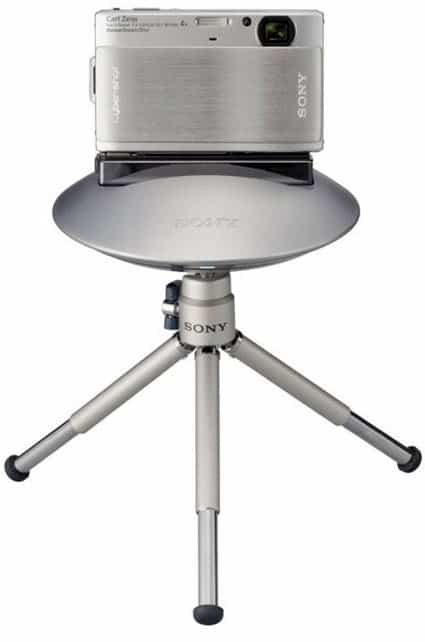In 2000, prior to Portigal Consulting, we conducted an ethnographic study with Sony to “provide awareness of unarticulated consumer perceptions about digital imaging on which to base future product development decisions…generating a range of new product and service concepts.”
Over the years we’ve seen Sony launch products that are similar to ones we proposed (see example here). We identify opportunities for our clients; the path they take to develop (or not) can be complex and fraught, and many opportunities are not addressed in the marketplace (although we find our clients value how our work helps them make that decision).
Here’s the latest:

Sony today introduced the Party-shot personal photographer -an innovative camera dock that pans 360 degrees and tilts 24 degrees, automatically detects faces, adjusts composition and takes photos for you.
This device makes it easy to capture more natural expressions and fun, candid moments of you, your family and friends without having to hire a photographer.
“With the Party-shot personal photographer, you no longer have to worry about taking photos when you are with your family or friends,” said Shigehiko Nakayama, digital imaging accessories product manager at Sony Electronics. “Party-shot captures candid moments that tell natural life stories and also offers a new style of photography that enriches time with your family and friends.
From our 2000 presentation to Sony
Market Opportunity�: Freedom to Participate
Today
Defined set of occasions where
- camera visibility/ interference is possible and accepted
- cameraman takes on an assumed role
Opportunity to Increase Usage
- Design cameras that are less bulky, obtrusive, “precious”
- Enable experiences to be preserved without requiring someone to operate a camera
Our concept (to illustrate the opportunity) emphasized video over still

Product Feature: Full Remote Control
- Gives capturer full control over video camera while away from device
- Includes viewfinder, volume, zoom/pan/tilt, battery/tape indicator
- Capturer is not “tethered” to camera and can participate
Sony isn’t the only one to launch products that we identified. As we identified needs and proposed solutions, it’s inevitable that as time goes by, competitors will identify those needs and develop products. For example, three years ago I blogged about Granny’s Inbox where HP launched something similar to one of our Sony concepts.
Elsewhere, we see other products that have been developed by competitors since our work for Sony in 2000:
Digital Blue’s Tony Hawk Helmetcam

and our X-treme Cam concept

- Rugged, mountable video camera that captures short clips from the user’s point of view
- Sharable, relivable document of exciting experiences
- Appeals to teens and/or sports participants
- Must be made inexpensive enough to justify its very specific (and thus limited) functionality
Hasbro’s VuGo Multimedia System

and our MPEG-Man concept

- Plays short clips of digital video
- Like a photo album, device can be passed around for sharing in a larger group
- Connect to TV, PC, or projector
- Better group interactions for sharing video
- Position as everyday, casual, social device rather than hi-tech or novelty
Casio EXILIM (and other models of still and video cameras from other manufacturers) feature Pre-Record Mode where
photos are not only taken at the moment the shutter release is pressed – they’re also taken before that! With continuous recording of up to 30 photos per second, a maximum of 25 photos can be saved in the camera’s buffer memory – even before the shutter release is pressed. The 25th image then corresponds to the photo that was taken when the shutter release button was pressed. This means that, in addition to the photo that you took at the moment the shutter release button was pressed, you can choose from a further 24 images that occurred just before that moment.
and our Capture Buffer concept (video but could be used for still as well)

- Video camera is always capturing and discarding footage
- When user initiates recording, option of saving the contents of the buffer
- People will no longer miss the beginning of what they want to film
- Slightly more skill required by users – where was the camera pointing before the button is pressed?
Buffalo TeraStation Home Server

and our Digital Memory Vault concept

- Permanent digital storage for stills and video
- Indexing, organizing, online publishing
- Random access retrieval
- Simplifies organization and retrieval of images (and video)
- Leverages familiar (to PC users) activity of searching (i.e., web search)
- Appeals to customers who are already invested in digital imaging, or in legacy imaging (i.e., family albums)
- Challenge to deliver expected bullet-proof reliability at an acceptable price point
Samsung TL225 with front LCD to prompt subject to smile, etc.

and our Teleprompter Cam concept (video but could be applied to still)

- Image on screen prompts subject to pose for video
- Helps people feel comfortable in front of a video camera
- Positioning challenge: though most images are posed and theatrical, our culture privileges the capture of candid and “natural”



























